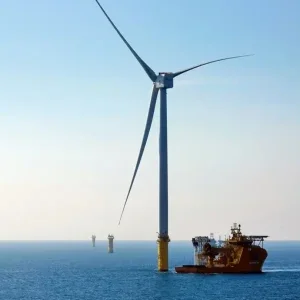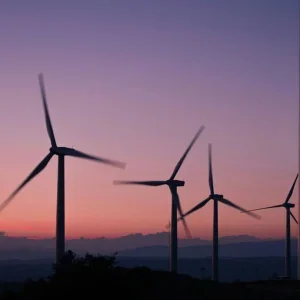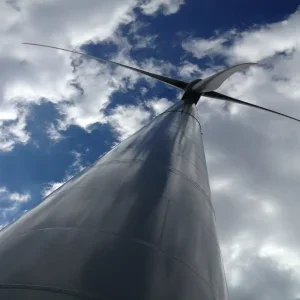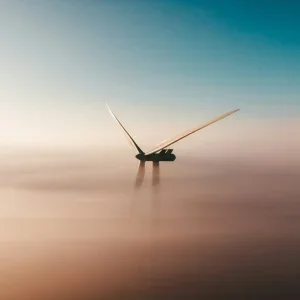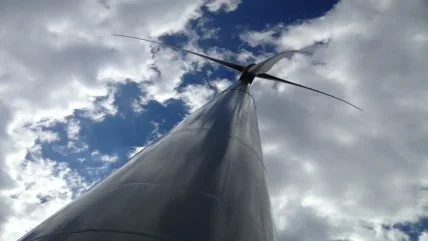
While the EU has set a target for 43% of its electricity consumption to be met by wind generation by 2030, up from 17% today – requiring 30GW of new wind farms every year – the industry currently faces a perfect storm. In the recovery period after the pandemic, ‘cheap money’ has been abandoned as interest rates have risen in response to inflation escalation; technological issues as turbines become larger; and the longer-term threat of Chinese players dominating the European wind space with more competitive financing offerings. There’s certainly cause for concern.
Against this backdrop, previously secured competitive tenders that locked in their remuneration schemes are now suddenly less competitive and lowering returns are leading to greater caution. Indeed, some projects have even seen developers willing to pay termination fees to get out of their projects.
An extreme example of the state of the industry can be seen in the recent catastrophic failure of a UK wind auction in September, where potentially up to 5GW of projects – enough to power eight million homes a year – were up for grabs.
Though contracts for a total of 3.7GW of solar power, onshore wind and tidal power projects were secured, the offshore wind farm space saw no takers – with developers baulking at the UK government’s offer of £44 per megawatt hour (MWh), which was seen by potential bidders as being far too low to make investment worthwhile. So, what can be done to address this?
Bigger isn’t always better
Contractual costing issues aside, an obvious solution would be to build bigger turbines. Yet, with that comes new issues. Just ask Siemens Gamesa, which recently confirmed mounting problems with malfunctioning turbines coupled with unprofitable contracts that have led to the company expecting an overall €4.5bn net loss this year. This includes a €2.2bn charge related to its wind division, over specific issues including wrinkles in rotor blades and the presence of unspecified particles in the bearings sections.
Despite these problems, the CEO of the group’s wind division, Jochen Eickholt, has been quick to note that the group had made progress with its turnaround. Of the €2.2bn charge, €1.6bn is being earmarked for quality issues around rotor blades and gears for its latest onshore turbine models, the 4.X and 5.X, of which roughly 2,900 are in the field. Turbines currently being sold to customers have already been modified to address these issues.
In the meantime, energy analysts at Wood Mackenzie have called for a temporary cap of up to ten years on the size of wind turbines, arguing it would provide greater clarity for developers regarding their projects. The past few years have seen ever-larger turbines increasingly placing unnecessary pressure on supply chains, with both installation vessels and factories unable to keep up with existing projects. On the other hand, Guy Willems, strategic communications adviser at trade body WindEurope, is quick to argue that turbine sizes aren’t the sole bottleneck for European offshore turbine manufacturers – at least when it comes to supply chains.
“Other factors could have a bigger impact on sustaining the health of the European supply chain,” he says. “First of all, permitting needs to be improved for offshore projects. It takes far too long for projects to go through the full bureaucratic procedure.”
Willems notes that governments across Europe are yet to digitalise this process, with many still requiring the full permitting application to be printed – which can cost thousands of euros, further complicating matters.
However, the revised Renewable Energy directive, adopted on 9 October, finally takes steps to address this shortcoming, he adds. Governments also need to provide clear pipelines for projects that the industry can adapt to, which should come together with an increase in market volumes.
Buying time
Yet, while larger turbines offer significant benefits, reducing space use and increasing electricity output – making them essential to Europe as it attempts to reach its energy and climate targets – that’s not to say they don’t pose additional problems for the industry.
“The turbines that are being installed right now are significantly bigger than the ones installed only a couple of years ago. We have to ensure that innovation in turbine technology comes at a healthy pace for the wider supply chain – the increasing speed of new turbine sizes has been too fast in recent years,” Willems concedes. “It needs to slow down to allow for supply chain investments – [including] vessels, logistics, ports [and so on].”
“Turbine sizes have grown gradually in the offshore space, compared to onshore, where it was frenetic.”
Shashi Barla
Shashi Barla, director and head of research for renewable energy at research consultancy Brinckmann, echoes many of Willems’ arguments. However, he finds it important to highlight the fact that offshore wind capital expenditure (capex) costs declined by more than 50% from 2015 through 2022, and attributes much of this success to increases in the size of wind turbines.
“Turbine sizes have grown gradually in the offshore space, compared to onshore, where it was frenetic,” Barla notes. “So, developers are often choosing larger rated turbines for their projects to save on the project capex. However, the increase in turbine sizes exerts pressure on the supply chain, both turbine and the balance of the plant (BoP).”
Increasing supply chain capacity with regard to wind turbines is one challenge, which the industry could potentially manage – the greater obstacle, however, are the various supporting components and auxiliary systems that make up the BoP, which consists of everything a power plant requires to deliver energy, beyond the generating unit itself.
32.4%
The percentage of the UK’s electricity generation made up by wind power in the first quarter of 2023.
Imperial College London
Among these, the lack of existing installation vessels provides a notable cause of concern for Barla, and larger and larger vessels will need to be built in order to construct increasing huge turbines offshore.
“Installation vessels will typically cost around $400–500m if built in the EU or US,” he says, beginning to illustrate the challenge inherent to this demand. “Meanwhile, day rates, prior to 2022, were typically around 200–250K – this implies that the vessels can be profitable in eight to ten years.
“Yet, if we look at the turbine technology evolution, it is between four and five years. So, [new] vessels will be redundant in five years, before they break even,” Barla concludes. “This is a big risk for the industry – [which is why] the vessel bottleneck is more pronounced than other components.”
“[Chinese turbine manufacturers] come into the European market with cheaper turbines, looser standards and unconventional financial terms.”
Guy Willems
Consequently, he adds, having a cap on turbine size may not be the single right solution to tackle this challenge. “Developers will need larger rated machines to lower the costs. The regulators must ensure that there is sufficient project pipeline available for the supply chain to invest into new facilities [or] expand existing facilities to meet the demand.
“If the supply chain, including the vessel owners, have sufficient volumes, then they would be happy to provide equipment for the next-generation turbine technologies. So, easing the permitting process, streamlining the auctions, renegotiating the power purchasing agreements with the offshore developers and increasing the price levels – baking in the increased costs of input material including commodities – will be some of the solutions to address the challenges.”
While offshore turbine order intake for OEMs more than doubled in the first three quarters of 2023, compared with 2022 – a record – Barla points out that developers are also cautious when it comes to signing and locking turbine purchase agreements (TPAs), as the equipment will be delivered three to four years after the contracts are closed.
16MW
The single-unit capacity of the biggest currently functioning wind turbines – Goldwind’s GWH252-16MW and Mingyang Wind Power’s MySE 18.X-28X.
Offshore Wind
“It is very uncertain for the OEMs to account for the direction of the cost evolution,” he adds. “One of the ways to mitigate this challenge is that the developers and OEMs might enter into contracts that are indexed to raw material prices and commodities – [for example] the shared pain shared gain model. If prices rise, both parties share the risks and if the costs come down, then both share the gain.”
Undercut by China
At the same time, the industry also faces the longer-term threat of Chinese wind turbine manufacturers undercutting domestic operators, which has greatly contributed to the challenges facing European wind energy.
“[Chinese turbine manufacturers] come into the European market with cheaper turbines, looser standards and unconventional financial terms,” claims Willems, noting that in some cases they “are offering wind turbines at prices up to 50% cheaper than what European turbine manufacturers can offer at the moment. [They] have also made use of financing mechanisms that European OEMs cannot offer, among them deferred payments of up to 3 years on wind turbine orders.”
Barla, however, is less concerned over any threat posed by Chinese turbine manufacturers and doesn’t necessarily think the market will open up for Chinese OEMs – not least because of their limited track record in the European wind space.
“Until the end of 2022, more than 80% of the Chinese 30GW cumulative fleet [of wind turbines] had been sub-6MW machines,” he explains. “Chinese OEMs only installed 6–8MW machines in the past two to three years. So, they lack a track record regarding the 14–15MW machines Western developers are choosing.”
Moreover, 6–8MW machines – and more recently 8–10MW options – are more relevant in lower wind speed areas such as South Korea, Japan and Vietnam, which are all markets Chinese OEMs have been focusing on.
“Geopolitical decisions will also play a crucial role in these projects,” Barla adds. “Large infrastructure projects, such as offshore wind, will undergo stringent scrutiny with regard to security, digital security, HSE standards [and so on]. So, it makes it slightly challenging for Chinese companies, [and as a result] markets like the US, and conventional northern and western EU markets, may not be target markets for Chinese OEMs.”
Similarly, regional content policies also have a large role to play, as Chinese OEMs seeking to operate in the EU will likely be required to invest in manufacturing facilities in Europe first. If this occurs, the cost benefits attributed to Chinese machines over Western ones will decrease, forcing developers to rethink their long-term strategies.
With all of this in mind, it would be no exaggeration to say the wind industry is facing headwinds – with many of the issues now firmly entrenched. With a bottleneck over offshore construction inevitable due to a lack of installation vessels, a temporary ban or similar restriction on further wind turbine growth would go a long way towards providing the sector with the time to address gaps in its supply chain.
Even if China’s turbine manufacturers steer clear, the demand is there for larger turbines – it’s on the industry to resist the call.


